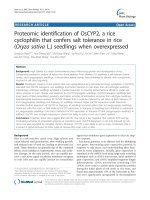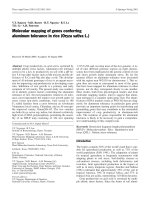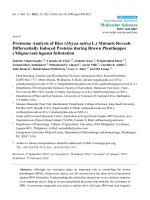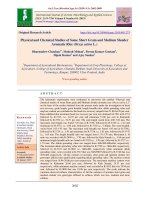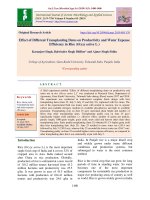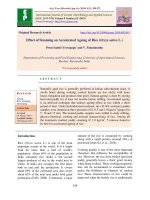Involvement of phenolics in allelopathy and submergence tolerance of rice (oryza sativa l )
Bạn đang xem bản rút gọn của tài liệu. Xem và tải ngay bản đầy đủ của tài liệu tại đây (2.71 MB, 150 trang )
Involvement of Phenolics in Allelopathy
and Submergence Tolerance of Rice (Oryza sativa L.)
D141228
DO TAN KHANG
A Dissertation Submitted to
the Graduate School for International Development and Cooperation
of Hiroshima University in Partial Fulfillment
of the Requirement for the Degree of
Doctor of Philosophy
September 2017
We hereby recommend that the dissertation by (Mr. DO TAN KHANG entitled
“Involvement of Phenolics in Allelopathy and Submergence Tolerance or Rice (Oryza
sativa L.)” be accepted in partial fulfillment of the requirements for the degree of
DOCTOR OF PHILOSOPHY.
Committee on Final Examination:
XUAN Tran Dang, Associate Professor
Chairperson
NAKAGOSHI Nobukazu, Professor
TSUDZUKI Masaoki, Professor
MAEDA Teruo, Professor
TAWATA Shinkichi, Professor
PAK Research Center, University of the Ryukyus
Date:
Approved:
Date:
Baba Takuya, Professor
Dean
Graduate School for International Development and Cooperation
Hiroshima University
Contents
LIST OF FIGURES .................................................................................................... vi
LIST OF TABLES .................................................................................................... viii
ABSTRACT .................................................................................................................. 1
CHAPTER 1. INTRODUCTION ............................................................................... 6
1.1
Background .................................................................................................... 6
1.1.1
Problem in rice production ....................................................................... 6
1.1.2
Allelopathy in rice .................................................................................. 11
1.1.3
Phenolics ................................................................................................ 13
1.2
Research objectives ..................................................................................... 17
1.3
Thesis structure ........................................................................................... 17
CHAPTER 2. ALLELOPATHIC ACTIVITY OF DEHULLED RICE AND ITS
EFFECTS ON WEED GERMINATION ................................................................. 19
2.1
Introduction ................................................................................................. 19
2.2
Materials and methods ................................................................................ 21
2.2.1
Plant materials ........................................................................................ 21
2.2.2
Chemicals ............................................................................................... 21
i
2.2.3
Effects of dehulled rice and hulls on germination of test plants ............ 21
2.2.3
Identification of phenolics released from root exudates ........................ 23
2.2.4
Data analysis .......................................................................................... 25
2.3
Results and discussion ................................................................................. 26
2.3.1
Effects of rice, dehulled rice and hulls on germination of test plants .... 26
2.3.2
Identification of allelopathic phenolics .................................................. 30
2.4
Conclusions .................................................................................................. 34
CHAPTER 3. EFFECTS OF SELECTED PHENOLICS ON GERMINATION
AND SEEDLING GROWTH OF PLANTS ............................................................ 35
3.1
Introduction ................................................................................................. 35
3.2
Materials and Methods ............................................................................... 36
3.2.1
Plant materials ........................................................................................ 36
3.2.2
Effects of phenolic acids on germination of rice and test plants ............ 36
3.2.3
Data analysis .......................................................................................... 37
3.3
Results and discussion ................................................................................. 37
3.4
Conclusions .................................................................................................. 44
CHAPTER
4.
INVOLVEMENT
OF
PHENOLIC
COMPOUNDS
IN
ANAEROBIC FLOODING GERMINATION OF RICE ...................................... 45
ii
4.1
Introduction ................................................................................................. 45
4.2
Materials and methods ................................................................................ 47
4.2.1
Plant materials ........................................................................................ 47
4.2.1
Chemicals and reagents .......................................................................... 47
4.2.2
Screening of germination under flooding conditions ............................. 47
4.2.3
Screening of sub-1 gene using SSR markers ......................................... 48
4.2.4
Phenolic extraction ................................................................................. 50
4.2.5
Estimation of total phenolic content ...................................................... 51
4.2.6
Determination of total flavonoid content ............................................... 52
4.2.7
Identification of phenolic acids of seedling extracts .............................. 53
4.2.8
Evaluation of antioxidant activity .......................................................... 53
4.2.9
Statistical analysis .................................................................................. 54
4.3
Results and discussion ................................................................................. 54
4.3.1
Screening anaerobic germination of different varieties under flooding
conditions ............................................................................................................. 54
4.3.2
Screening of sub-1 gene in rice varieties ............................................... 60
4.3.3
The effect of flooding conditions on the total contents of phenolic
compounds in anaerobic germination of rice varieties ........................................ 65
iii
4.4
Conclusions .................................................................................................. 74
CHAPTER 5. ENHANCEMENT OF CHLOROPHYLL, TOTAL PHENOLICS
AND ANTIOXIDANT ENZYMES OF RICE DURING SUBMERGENCE
USING EXOGENOUS PHENOLICS ...................................................................... 75
5.1
Introduction ................................................................................................. 75
5.2
Materials and methods ................................................................................ 77
5.2.1
Plant material and treatments ................................................................. 77
5.2.2
Measurement of lipid peroxidation ........................................................ 78
5.2.3
Determination of chlorophyll contents ................................................... 79
5.2.4
Estimation of total phenolic and flavonoid contents .............................. 79
5.2.5
Evaluation of antioxidant activity .......................................................... 82
5.2.6
Enzyme extractions and assays .............................................................. 83
5.2.7
Gene expression of antioxidant enzymes using quantitative real-time
PCR
................................................................................................................ 85
5.2.8
Statistical analyses ................................................................................. 86
5.3
Results and discussion ................................................................................. 87
5.3.1
Effect of exogenous phenolics on stem elongation ................................ 87
iv
5.3.2
Effect of exogenous phenolics on photosynthetic pigments and lipid
peroxidation.......................................................................................................... 87
5.3.3
Effect of exogenous phenolics on total phenolic and flavonoid contents ..
................................................................................................................ 89
5.3.5
5.4
Effect of exogenous phenolics on antioxidant enzymes ........................ 92
Conclusions .................................................................................................. 99
CHAPTER 6. ISOLATION OF ALLELOCHEMICALS FROM RICE HUSKS ...
.................................................................................................................................... 100
6.1
Introduction ............................................................................................... 100
6.2
Materials and methods .............................................................................. 102
6.2.1 Materials .................................................................................................... 102
6.2.1 Methods ..................................................................................................... 102
6.3
Results and discussion ............................................................................... 104
6.3.1 Isolation of compounds ............................................................................. 104
6.3.2
6.4
Allelopathic potential of isolated compounds ...................................... 108
Conclusions ................................................................................................ 112
CHAPTER 7. GENERAL DISCUSSION .............................................................. 113
REFERENCES ......................................................................................................... 120
v
List of Figures
Fig. 1.1 Rate of changing flood risk (“R”) in main deltas in the world. The color and
size of the circles represent the level of risk (Tessier et al., 2015) ................................ 8
Fig. 1.2 The 12 most troublesome weeds of rice in Asia ............................................. 10
Fig. 1.3 The biosynthetic pathways of the common allelochemicals (Li et al., 2010) 12
Fig. 1.4 Induction, production, release and transport of allelochemicals and their
effects (Amb and Ahluwalia, 2016) ............................................................................. 13
Fig. 1.5 Phenolic classification .................................................................................... 16
Fig. 2.1 Intact rice (A), dehulled rice (B) and hull (C) ................................................ 22
Fig. 2.2 Diagram of seed distribution in a Petri dish ................................................... 22
Fig. 2.3 HPLC chromatogram of phenolic standards .................................................. 24
Fig. 2.4 Germination of tested plants after 2 days ....................................................... 26
Fig. 4.1 Submergence treatments of rice ..................................................................... 48
Fig. 4.2 Standard curve of gallic acid .......................................................................... 51
Fig. 4.3 Standard curve of rutin ................................................................................... 52
Fig. 4.4 DNA electrophoresis image of rice varities ................................................... 60
Fig. 4.5 PCR profile of the marker RM219 on rice varieties ....................................... 61
Fig. 4.6 HPLC chromatogram of standard phenolic acids (A) and rice leaves of the
strong tolerant variety before (B) and after submergence treatment (B) ..................... 69
Fig. 4.7 HPLC chromatogram of standard phenolic acids (A) and rice leaves of the
weak tolerant variety before (B) and after submergence treatment (B) ....................... 70
Fig. 4.8 Antioxidant activity (DPPH scavenging) of samples ..................................... 72
vi
Fig. 5.1 HPLC chromatogram of protocatechuic acid (1) and vanillic acid (2) .......... 81
Fig. 5.2 HPLC standard curves of protocatechuic acid ............................................... 81
Fig. 5.3 HPLC standard curves of vanillic acid ........................................................... 82
Fig. 5.4 Changes of chlorophyll a (A), chlorophyll b (B), and MDA (C) contents of
rice after pre-treatment with phenolic acids. ................................................................ 88
Fig. 5.5 Variation of total phenolic (A), total flavonoid (B), protocatechuic acid (C),
and vanillic acid (D) contents in rice after pre-treatment with phenolic acids. ........... 90
Fig. 5.6 Antioxidant activity of rice extracts after phenolic acid treatment ................ 91
Fig. 5.7 Changes of antioxidant enzyme activities in rice after pre-treatment. ........... 93
Fig. 5.8 Comparison of relative expression of antioxidant enzymes after phenolic acid
pre-treatment (Error bars are based on standard errors) ............................................... 94
Fig. 6.1 Identified rice allelochemicals (Macías et al., 2007).................................... 101
Fig. 6.2 Bioassay test using Petri dish method .......................................................... 104
Fig. 6.3 TLC photo of the compounds ....................................................................... 105
Fig. 6.4 TLC photo of the compounds after separation ............................................. 105
Fig. 6.5 GC chromatograms of compounds (1) and (2) ............................................. 106
Fig. 6.6 Mass spectra of compound (1) and (2) ......................................................... 107
Fig. 6.7 Allelopathic potential of compound (1) and (2) on radish ........................... 111
Fig. 6.8 Effect of compound (1) on early growth of radish ....................................... 112
vii
List of Tables
Table 1.1 Rice area and yield in Asian countries by different areas (Swain et
al., 2005) ........................................................................................................................ 7
Table 1.2 Classes of phenolic compounds in plants .................................................... 14
Table 2.1 Retention times and standard curve of individual phenolic acids ................25
Table 2.2 Effects of intact rice, dehulled rice and hulls on germination and seedling
growth of barnyardgrass, expressed as different percentages over controls ................ 27
Table 2.3 Effects of intact rice, dehulled rice and hulls on germination and seedling
growth of lettuce, expressed as different percentages over controls ............................ 28
Table 2.4 Effects of intact rice, dehulled rice and hulls on germination and seedling
growth of radish, expressed as different percentages over controls ............................. 29
Table 2.5 Phenolic acids (µg ml-1 extract) in agar media of weeds and rice after oneweek germination ......................................................................................................... 32
Table 3.1 Effects of allelochemicals on germination and seedling growth of
barnyardgrass, expressed as different percentages over controls ..................................38
Table 3.2 Effects of allelochemicals on germination and seedling growth of lettuce,
expressed as different percentages over controls ......................................................... 39
Table 3.3 Effects of allelochemicals on germination and seedling growth of radish,
expressed as different percentages over controls ......................................................... 40
Table 3.4 Effects of allelochemicals on germination and seedling growth of rice,
expressed as different percentages over controls ......................................................... 41
Table 4.1 List of SSR markers linked to sub-1 gene ....................................................49
Table 4.2 Germination rates of different varieties at 14 days after sowing ................ 55
viii
Table 4.3 Shoot heights of different varieties at 14 days after sowing ....................... 57
Table 4.4 Seedling vigor index of different varieties at 14 days after sowing ............ 59
Table 4.5 Allele sizes (bp) of marker RM219 on 30 rice varieties ............................. 62
Table 4.6 Correlation (r) of seedling vigor index and germination rates of different
varieties at 14 days after sowing .................................................................................. 65
Table 4.7 Changes of total phenolic and flavonoid contents of the strong and weak
flooding-tolerance varieties .......................................................................................... 66
Table 4.8 Phenolic acids and concentrations (µg g-1 DW) of strong and weak flooding
tolerance varieties ......................................................................................................... 68
Table 5.1 Primer sequences of the selected antioxidant enzyme genes .......................86
Table 5.2 Node length and plant height of rice after 1 week of phenolic treatment ... 87
Table 5.3 Correlation (r) among measured parameters relating to phenolics, flavonoids,
lipid peroxidation, chlorophylls and antioxidant enzyme activities. ............................ 96
Table 6.1 EI mass spectra of the isolated compounds ................................................107
Table 6.2 Effects of compounds (1), (2) and their mixture on shoot height (mm) of
radish .......................................................................................................................... 109
Table 6.3 Effects of compounds (1), (2) and their mixture on root length (mm) of
radish .......................................................................................................................... 110
Table 6.4 Effects of compounds (1), (2) and their mixture on germination rate (%) of
radish .......................................................................................................................... 111
ix
ABSTRACT
Rice (Oryza sativa L.) is an essential food crop for billions of people, and it
plays a crucial role in the relation of diet and health. Considered as one of the
inevitably devastating consequences caused by climate change, damaged rice crops
have increased tremendously around the world. Flood is considered as one of the
major challenges for rice production, especially in the South and Southeast Asia that
imposes major limitations on productivity and viability of agricultural crops
worldwide. Among important crops, rice (Oryza sativa L.) is mostly affected by
submergence stress because many rice landraces are primarily cultivated in lowland
and flood-prone areas. Additionally, weed is also one of the most serious problems
facing rice production around the world. Although herbicides are economical and
effective, they cause devastating effects on the environment, human health and the
high risk of herbicide resistance of weeds that may threaten sustainable crop
production. To tackle the mentioned challenges in weed management, biologically
novel treatments of weeds should be prioritized, one of which is using allelopathy as
an effective and efficient manner due to its cost effective and eco-friendly aspects.
Rice has a process for overcoming the stress of flooding; a pathway that
produces antioxidants as secondary metabolites, phenolics included. Moreover, some
rice varieties release phenolics which might affect major weeds around rice plants.
Therefore, it is important to recognize that finding phytochemicals – either those that
1
can enhance the submergence tolerance of rice or those that suppress noxious weeds
in the field - is necessary to maintain environmentally-friendly agriculture. To
achieve the research objectives, four main experiments were conducted.
The identifications of the allelochemicals of dehulled rice, rice, and hulls of rice
were carried out in laboratory. Phenolic acids in growth media of rice seeds and
tested plants (barnyardgrass, lettuce, radish) were identified and quantified using
HPLC. The results showed that the inhibitory effects of dehulled rice were stronger
than those of hulls and rice. The results also demonstrated that both rice and dehulled
rice resulted in the decrease in lettuce shoot elongation, with 50.6 and 30.4%,
respectively. The results revealed inhibitory effects of dehulled rice on root length,
shoot height and survival rate of barnyardgrass, lettuce, and radish. Regarding
phenolic identification, there were ten phenolic acids including gallic, protocatechuic,
chlorogenic, vanillic, syringic, ferulic, benzoic, ellagic, cinnamic acids and vanillin
detected in rice and dehulled rice root exudates, while syringic and ferulic acids were
only detected in dehulled rice. Vanillin and vanillic acid were detected as
allelochemicals in root exudates of rice and tested plants, indicating that vanillin and
vanillic acid played the main role in alleopathic interaction of rice and the tested
plants.
2
To clarify the allelopathic potential of vanillin and vanillic acid, the putative
chemicals were purchased for treatments. The chemicals were applied with three
concentrations of 50 ppm, 100 ppm and 200 ppm which were directly added to agar
solution for seed germination. The recorded data revealed that most of the vanillin
and vanillic acid treatments showed high inhibitory effects on germination rates and
seedling growth of lettuce and radish, but strongly stimulated root elongation of rice.
The phenolic concentration of 200 ppm was found to have the most negative effect
on germination rate of lettuce. Survival rates of lettuce and radish were significantly
reduced when exposed to various concentrations of phenolic treatments. Particularly,
no lettuce was observed to survive after treated with vanillic acid (100 ppm), vanillin
(100 ppm), and mixture (200 ppm). Moreover, vanillic acid also showed an
inhibitory effect on the survival rate of barnyardgrass at 100 ppm treatment. The
findings indicated the allelopathic potential of dehulled rice which can be used for
identification of more phytotoxins to produce bioherbicides.
In addition, phenolic acid profiles of strong and weak submergence-tolerant rice
varieties were identified and compared based on HPLC chromatograms. The results
showed a high variation of germination rate (from 10 to 100%), shoot height (0.35 to
78.17 mm) and seedling vigor (0.05 to 72.83). Total phenolic and flavonoid contents
of the strong tolerant cultivar significantly increased in the submergenc. There was a
big difference in terms of number of phenolic acids found in the tolerant and
3
susceptible varieties. In particular, six phenolic acids (gallic acid, catechol, caffeic
acid, syringic acid, vanillin, and ellagic acid) were only identified with high
concentration in the tolerant cultivar. Moreover, protocatechuic acid, chlorogenic acid,
vanillic acid, benzoic acid and cinnamic acid significantly increased in the anaerobic
flooding condition. The findings suggest that the phenolics increased in the strong
tolerant varieties have a certain function in response and adaptation to anaerobic
flooding condition.
Subsequently, the impacts of protocatechuic acid and vanillic acid on total
phenolic, chlorophyll, malondialdehyde (MDA) contents and antioxidant enzyme
activities of rice seedlings in submerged condition were evaluated. Amount of
chlorophyll b after pre-soaked with 0.1 mM protocatechuic acid markedly increased
by 40% compared to the untreated plants (p < 0.05) while that of chlorophyll a was
negligibly different. Vanillic acid significantly reduced MDA quantity from 43.0±3.4
to 15.5±3.0 nmol/g fresh weight. By treating plant with protocatechuic acid and
vanillic acid, the total endogenous phenolic and flavonoid contents, the activities of
superoxide dismutase (SOD) and ascorbate peroxidase (APX) were strongly
promoted. Similarly, the expression of genes encoding for antioxidant enzymes was
elevated. In addition, vanillic acid increased the expression level of APX gene in
much higher levels than that of protocatechuic acid and their mixture, whilst no
significant difference was observed in the other genes including SOD, CAT
4
(catalase), GR (gluthione reductase), and POD (peroxidase). The findings of this
study highlighted the positive roles of protocatechuic acid and vanillic acid in
photosynthetic and antioxidative processes in rice seedlings during submergence,
potentially helping promote the submergence tolerance in rice.
Briefly, among detected phenolics, vanillic acid was the phytochemical
possessing both allelopathic potential and enhancement of submergence tolerance of
rice. With the high concentration (200 mM), such phenolic acid could suppress the
germination and early emergence of weeds while the low concentration (0.1 mM)
improved the physiological processes of rice under submergence by increasing
chlorophyll content, enhancing antioxidant enzyme activities, and reducing lipid
peroxidation. The findings in this study not only provide new information as to the
physiological role of phenolics in rice, focusing on allelopathy and submergence
tolerance, but also can be treated as the foundation to build protocols for agricultural
practices - the involved phenolics can be applied in controlling weeds and boosting
the submergence tolerance of rice.
5
Chapter 1. Introduction
1.1 Background
1.1.1
Problem in rice production
Rice is one of the most crucial crops of the world and the staple food for more
than half of the world’s population. Actually, there are more than 3.5 billion people
daily consuming rice for their calorie demand. Rice is grown on a total harvested
area of approximately 158 million hectares, annually producing more than 700
million tons (470 million tons of milled rice) (Seck et al., 2012). About 90% of the
rice in the world is grown in Asia (nearly 640 million tons), with India and China
as the top producers, following by Bangladesh, Indonesia, Thailand and Vietnam
(Table 1.1). Rice is one of the most adaptable crops that can be cultivated in
diverse ecological zones including dry and wetland conditions and low and high
altitudes such as the Mekong delta in Vietnam or the highlands of Madagascar.
6
Table 1.1 Rice area and yield in Asian countries by different areas (Swain et
al., 2005)
Country
Total area
(m ha)
Rainfed lowland
Flood-prone
Area
(%)
Yield
(t/ha)
Area
(%)
Yield
(t/ha)
Bangladesh
10.24
43.1
4.3
24.1
2.5
Bhutan
0.03
3.8
–
42.3
–
China
33.01
5.6
3.0
0.0
–
India
42.64
30.1
2.4
11.4
1.5
Indonesia
10.28
7.8
3.0
6.4
1.7
Japan
2.05
0.0
–
0.0
–
Myanmar
4.57
52.8
3.0
14.3
1.5
Nepal
1.41
60.6
2.2
13.3
0.8
Philippines
3.42
32.0
2.0
2.0
1.3
Sri Lanka
0.79
14.9
2.5
1.1
1.0
Thailand
9.27
72.2
1.8
10.4
2.0
Viet Nam
6.30
23.4
2.0
16.3
1.5
Major issues on rice production over the world were commonly reported, such
as low temperature, water problems (drought, salinity and submergence), change in
soil properties, diseases and pests, and weed problems. Submergence has been
reported as the third most risk for rice yield among the 42 biotic and abiotic stresses
affecting rice production. In particular, rice cultivated in flood-prone areas has
significantly lower than rice grown in rainfed lowland regions in term of yield (Table
1.1). Flooding is widespread in India as well as South and Southeast Asian countries
7
including Bangladesh, Thailand, Vietnam, Myanmar and Indonesia (Fig. 1.1) (Sarkar
et al., 2006).
Fig. 1.1 Rate of changing flood risk (“R”) in main deltas in the world. The color and
size of the circles represent the level of risk (Tessier et al., 2015)
Flooding is one of the natural catastrophes inducing yield loss of crops
cultivated in flood-prone or coastal areas. Compared to other crops, rice (Oryza
sativa L.) is commonly cultivated in irrigated regions, and can adapt to different
levels of saturated water from drought to submergence in a short period (Setter and
Waters, 2003). However, rice is not able to completely tolerant to flooding.
Therefore, rice plants will die because of oxygen and light insufficiency in the case
of completely submerged or flooded for a long time (Perata and Alpia, 1993). Recent
studies have reported that rice plants have different tolerance mechanisms to adapt to
flooding or submergence.
Moreover, weed is one of the most serious problems facing rice production
around the world. In fact, weed invasion is responsible for more rice yield loss than
8
pests and diseases (Abbas et al., 1995). Traditionally, hand-weeding is primarily
applied to control weed in paddy fields; however, this approach costs a huge amount
of casual labor, which has declined due to fast industrialization (Olofsdotter, 1998).
This phenomenon makes the conventional weed management ineffective. As a
consequence, herbicides are increasingly employed as an inevitable alternative.
Annually, approximately three billion tons of herbicides are used in areas of
agricultural production all over the world (Chung et al., 2006). Although herbicides
are economical and effective, they cause devastating effects on the environment,
human health and an increase in the risk of herbicide resistance of weeds that may
threaten sustainable crop production (Moondy, 1991; Hong et al., 2002; Xuan et al.,
2004; Khanh et al., 2013). IRRI (International Rice Research Institute) has been
listed the 12 noxious weeds of rice in Asia, consisting of Cyperus iria, C. difformis,
Echinochloa colona, E. crus-galli, Eclipta prostrate, Fimbristylis miliacea,
Ischaemum rugosum Salisb., Leptochloa chinensis, Ludwigia hyssopifolia, Oryza
sativa, Schoenoplectus juncoides, and Sphenoclea zeylanica (Fig. 1.2).
To tackle the mentioned challenges in weed management for maintaining
sustainable rice production, biologically novel weed treatments should be prioritized,
one of which is using allelopathy as an effective and efficient manner due to its cost
effective and eco-friendly aspects (Khanh et al., 2013).
9
Fig. 1.2 The 12 most troublesome weeds of rice in Asia
(Source photo: />
10
1.1.2
Allelopathy in rice
Allelopathy is a phenomenon of plant and plant or microorganism interactions in
an ecosystem by the release of chemicals in the environment (Rice, 1984). The
formal term “Allelopathy” was first suggested in 1937 by Hans Molisch (an Austrian
plant physiologist) who has been recorded as the father of this interesting research
aspect. (Li et al., 2010). The chemicals produced by such interfere are called
allelochemicals which are necessary for survival of plants, but they do not have any
functions in metabolic processes. Based on the chemical structures and
characteristics of the compounds, allelochemicals are divided into the following
groups consisting of phenolics (cinnamic acid and its derivatives); flavonoids;
coumarins; steroids and terpenoids (sesquiterpene lactones, diterpenes, and
triterpenoids); tannins; water-soluble organic acids, straight-chain alcohols, aliphatic
aldehydes, and ketones; simple unsaturated lactones; long-chain fatty acids and
polyacetylenes; quinines (benzoquinone, anthraquinone and complex quinines). Fig.
1.3 briefly describes the biosynthetic pathways of common allelochemicals in plant
(Wang et al., 2006).
Many allelochemicals such as 5-hydroxy-2- indolecarboxylic acid, 5hydroxyindole-3-acetic acid, mercaptoacetic acid, 4-vinylphenol, trans-ferulic acid
(Song et al., 2004), ergosterol peroxide, 7-oxostigmasterol (Macias et al., 2005), 5,7-
11
4ƍ-trihydroxy- 3ƍ,5ƍ-dimethoxyflavone (Kong et al., 2006), 3-hydroxy- ȕ-ionone, 9hydroxy-4-megastigmen-3-one
(Kato-Noguchi
et
al.,
2011)
azelaic
acid,
tetradecanoic acid, 1,2-benzenedicarboxylic acid bis (2-ethylhexyl) ester, 1H-indole3-carboxylic acid, 1H-indole-5-carboxylic acid, 1H-indole-3-carboxyaldehyde, 3,4dihydroxyhydrocinnamic
acid,
3-hydroxy-4-methoxybenzoic
acid,
4-
hydroxycinnamic acid and 4-hydroxyhydrocinnamic acid (Rimando et al., 2001)
have been detected in rice.
Pyruvic acid
Glucose
Gallic
acid
Dehydroshikimic
acid
Tannic
acid
Shikimic acid
Acetum
Amino
acid
Phenylketonuric,
anthraquinone
Cinnamic acid
and derivatives
Flavonoid
Amino acid
Alkaloid
Fig. 1.3 The biosynthetic pathways of the common allelochemicals (Li et al., 2010)
12
Allelochemicals present commonly by a conjugated form in almost all plants
and any part of the plants, like leaves, culm, flowers, fruits, seeds, buds, pollen and
roots (Putnam, 1988). Plants or organisms respond to different stimuli through
synthesis and release of the allelochemicals. These chemicals are released into the
environment by means of volatilization, foliar leaching, root exudation,
decomposition of plant residue and debris incorporation into soils (Fig. 1.4).
Fig. 1.4 Induction, production, release and transport of allelochemicals and their
effects (Amb and Ahluwalia, 2016)
1.1.3
Phenolics
Phenolics is the largest widespread group of secondary metabolites released
from plants. Fundamentally, their structures are recognized by one or more hydroxyl
substituents (-OH) bonded directly to an aromatic hydrocarbon ring to produce
simple compounds like phenol or highly polymerized structures (Li et al., 2010;
13
Pereira et al., 2009; Banasura et al., 2006; Zeng et al., 2008). Phenolic compounds
consist of phenolic acids (benzoic acid and cinnamic acid derivatives), tannins, and
flavonoids (flavones, flavonols, flavanones, flavan-3-ols, anthocyanidins, isoflavones,
coumarins, stilbenes and lignans) (Figure 1.5) which are normally contained in plants
as secondary metabolites, and the concentration of such compounds differs from
plant to plant as well as stages of development (Xu et al., 2009; López-Amorós et al.,
2006; Ti et al., 2014; Pereira et al., 2009). Structurally, phenolics can be categorized
as shown in Table 1.2.
Table 1.2 Classes of phenolic compounds in plants
Class
General Structure
Simple phenolics, benzoquinones
C6
Hydroxybenzoic acids
C6–C1
Acethophenones, phenylacetic acids
C6–C2
Hydroxycinnamic acids, phenylpropanoids (coumarins, C6–C3
isocoumarins, chromones, chromenes)
Napthoquinones
C6–C4
Xanthones
C6–C1–C6
Stilbenes, anthraquinones
C6–C2–C6
Flavonoids, isoflavonoids
C6–C3–C6
Lignans, neolignans
(C6–C3)2
Biflavonoids
(C6–C3–C6)2
Lignins
(C6–C3)n
Condensed tannins (proanthocyanidins or flavolans)
(C6–C3–C6)n
14
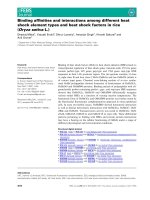
![Chemical and functional components in different parts of rough rice (oryza sativa l[1] ) beforeandaftergermination](https://media.store123doc.com/images/document/14/rc/qa/medium_qab1394872940.jpg)

